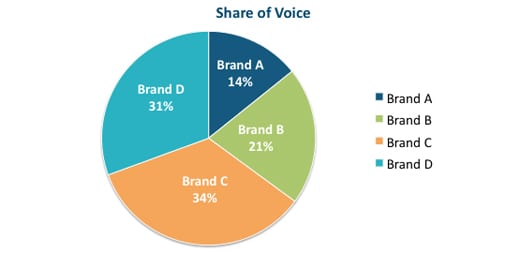This a short post that clarifies the “what is SOV?” query, and puts the concept in perspective. Share of voice is a very commonly used terminology in the marketing and advertising of brands. The term may sound complex and raise an eyebrow for someone who hears it for the first time.
But don’t be confused by that because it means exactly what you may have understood (or you would have been very close).
What is Share of Voice (SOV)?
Share of Voice Definition(s)
So, what does SOV mean? Abbreviated as SOV, share of voice is defined as the share of total advertising exposures that a brand gets.
In a nutshell, it is a way to measure a brand’s presence and to gauge how visible a brand was within an advertising medium during a specific time period. It is usually represented as a percentage of the total exposures.
Though it is vital to keep in mind that the share of voice definition, can vary from brand to brand. It can also depend on the methodology and the advertising medium used.
Share of Voice Calculation
If you’re wondering how to calculate share of voice, and you think it is a complicated process. You’re wrong. SOV calculation is as simple and straightforward as its definition.
However, you would need some marketing data about your competitors to be able to calculate it.
Share of voice can be calculated against the total industry, multiple categories, or your direct competitors.
Imagine a Telecom client, TELECOM-A, in an advertising / media market with a total of 100 ad exposures. If the total telecom exposures are 40 ads, and TELECOM-A’s exposure is 20 ads, then the SOV of TELECOM A would be 50% against competitors, and 20% against the industry.
Simple. No?
Most commonly, only your direct competitors are considered when calculating SOV.
That’s because you need to understand the competitive environment with relevance to your own brand.
Share of Voice Formula
Total advertising exposures that your brand gets (divided by) Total advertising exposures in your category.
This gives you the percentage of where you stand against your competitors, when it comes to gaining maximum visibility for your brand.
Differentiating Share of Voice
Following are a few different ways to look at share of voice (SOV), and how it can vary in it’s definition in each medium:
Share of Voice – Marketing
Think of SOV marketing as an umbrella term. It covers the overall marketing environment within which a brand operates. A marketing share of voice would mean, an overview of how a total brand’s marketing efforts fared against the marketing efforts of the whole category.
A Marketing Manager let’s say, would want to know his total brand visibility during a campaign, against the total available visibility opportunities that his competitors took a share in.
For example, if there are a total of 10 marketing exposure opportunities in a single consumer’s average day (TV, mobile, outdoor, in-store, etc.), how many of these opportunities were used to advertise the brand’s message to the consumer?
So if he / she used only 4 opportunities, the linear equation says that SOV in this case is 40%.
This is only one way to look at it. But trying to work out a share of voice on an overall marketing basis on a linear model can be misleading. It is however, best to stick to specific mediums and try to figure out the share of advertising in each of them.
Share of Voice – Advertising
SOV advertising core media buying / planning term, and is often used interchangeably with SOV marketing; however, a marketer who clearly understands the difference between marketing and advertising, will never work on such assumptions.
To put it simply, share of voice for advertising, looks are your brand’s total exposures against total exposures of your brand and your competitors combined.
- For example, a total of 10 ads were aired in the water category on TV in a week;
- 6 of those ads are of your water brand.
- Your share of advertising would be 60%.
SOV advertising calculations are very important to analyse the media investments on TV, Outdoor, Digital, and all other advertising mediums.
Share of Voice – Digital Advertising
Calculating the digital SOV is very tricky, because every advertiser would calculate it differently. Within digital, you can calculate SOV for search (organic & paid). You can calculate SOV for social media.
You can also look at overall WOM generated during a campaign by the brand.
The problem with digital media is that every website, mobile app, social media platform, is a universe of audience in itself, and there is no concept, or authoritative body, that centralizes the data for all platforms.
Let’s look at some scenarios:
- Facebook doesn’t share its data with Twitter, or Youtube, or any other 3rd party. Same is the case for all other websites.
- How do you calculate the total display advertising volume because no one shares their advertising data because of confidentiality.
- There are open platforms, and then there are closed platforms. It’s comparatively easier to estimate the data from an open platform vs a closed platform
Because of these issues, we can estimate SOV within each platform on digital, but are not able to look at a complete picture across multiple platforms (as is the case with TV, Radio, Print & Outdoor, because we usually track data through one data monitoring research company).
Though a lot of digital planners use the term digital SOV for impactful full-screen ad formats, including website sponsorship, interstitial ads, and homepage/section takeovers.
This is misleading, and we don’t suggest you get into the habit of using “digital SOV” in this context.
Share of Voice – Social Media
SOV social media, as the name suggests, is the way to calculate your share of exposures on social media.
Before you can calculate this, you need to be precise in terms of which media will you consider, which competitors will you take into account and what will be your methodology.
Usually, there is no single methodology for social media SOV. Sometimes it is calculated based on the total number of exposures vs your exposures; other times social teams calculate it based on total engagements vs your engagements (also known as share of engagements – SOE).
The best way is to follow what makes sense to your brand, and your overall strategy.







